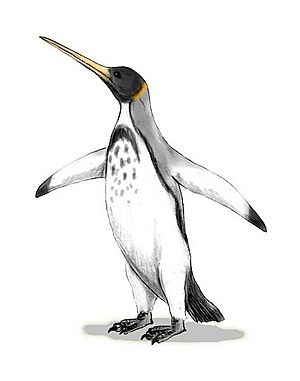Icadyptes facts for kids
Quick facts for kids Icadyptes |
|
|---|---|
 |
|
| Icadyptes salasi | |
| Scientific classification | |
| Genus: |
Icadyptes
|
| Species: |
salasi
|
Icadyptes was a type of giant penguin that lived a very long time ago, during a period called the Eocene (which was about 37 to 34 million years ago!). These amazing birds lived in warm, tropical areas of South America.
Contents
What's in a Name?
The name Icadyptes has a cool meaning! "Ica" comes from the Ica Region in Peru, which is where this ancient penguin was discovered. "Dyptes" is a Greek word that means "diver," which makes sense for a penguin! The second part of its name, "salasi," honors a famous Peruvian scientist named Rodolfo Salas Gismondi, who studies fossils.
Meet the Giant Penguin
Imagine a penguin as tall as a person! Icadyptes salasi stood about 1.5 metres (4.9 ft) tall. This makes it much bigger than any penguins alive today. Even so, it's only the third largest penguin ever found!
This ancient penguin had a very long, pointed beak. It looked a bit like the beak of a heron, which is a type of wading bird. Scientists think that this long, spear-like beak might have been the original shape for all penguins' beaks.
Discovery of Icadyptes
The fossil remains of Icadyptes salasi were found in the coastal desert of Peru. They were discovered by a team led by Dr. Julia Clarke, a scientist from North Carolina State University. These fossils are about 36 million years old!
The skeleton was very well-preserved. It was found in a place called the Otuma Formation. Along with Icadyptes, the team also found another ancient penguin called Perudyptes devriesi. This penguin was about the size of a modern King penguin. They also found parts of three other types of penguins that had never been seen before. All these ancient penguins seemed to prefer warm, tropical places, not cold ones.
How Penguins Evolved
The discovery of Icadyptes salasi and Perudyptes devriesi changed what scientists thought about how penguins evolved. These penguins lived in warm places when the Earth was much hotter than it is now. This was during a time when world temperatures were the warmest they had been in 65 million years! Today, only a few penguins, like the African penguin and Galapagos penguin, live in warm climates.
Before these fossils were found, many scientists believed that penguins first appeared near the poles, like in Antarctica and New Zealand. They thought penguins only moved to warmer areas about 10 million years ago. But since Icadyptes salasi lived in warm Peru about 36 million years ago, it means penguins must have adapted to warm climates much earlier than previously thought. This discovery helps us understand the amazing journey of penguins through history!
See also
 In Spanish: Icadyptes salasi para niños
In Spanish: Icadyptes salasi para niños

